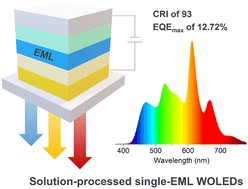Solution-processed single-emissive-layer WOLEDs with high efficiency and ultra-high color rendering index beyond 90†
Abstract
White organic light-emitting diodes (WOLEDs) have appealing applications in display technology. Developing WOLEDs based on cost-effective manufacturing processes is critical to the commercial pursuits of this technology. Solution-processed WOLEDs (SP-WOLEDs) constructed with a single emissive layer (EML) are a worthy candidate for development. To achieve SP-WOLEDs with high efficiency and high color quality, it is necessary to maximize the exciton utilization efficiency and to regulate the energy transfer process. Herein, three-color SP-WOLEDs were devised, with an EML containing blue and orange luminescent Au(III) complexes and the deep-red emitter tetraphenyldibenzoperiflanthene (DBP). The optimized WOLED exhibited high maximum external quantum efficiency of 12.72%, attributable to the high exciton utilization efficiency realized by doping a blue thermally activated delayed fluorescent Au(III) emitter and restraining exciton loss by DBP. High-quality warm-white emission was attained, with Commission International de l’Éclairage coordinates of (0.40, 0.40), correlated color temperature of 3695 K, and color rendering index (CRI) of 93, fulfilling the indoor lighting requirements. This result is among the best values for the single-EML SP-WOLEDs with CRI > 90 reported in the literature.

- This article is part of the themed collection: Photofunctional Materials and Transformations


 Please wait while we load your content...
Please wait while we load your content...